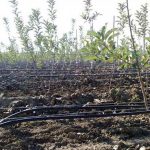Layout and plotting of intensive gardens
The intensive garden establishment project addresses the main organizational and agro-technical issues, taking into account the agroclimatic conditions:
- array characteristic;
- total area allocated to the plantation;
- garden location (plain, slope, exposure, steepness, etc.);
- soil type, subsoil, level of subsurface water;
- territory organization;
- general layout (the plan of breakdown into strips, sections and allocation of public areas is enclosed);
- land plot water supply;
- etc.
The main goal is to create high-yield intensive gardens, ensure the reasonable use of agricultural land, reduce the time to the onset of fruiting and use of pesticides, etc.
Orchard design addresses the following major problems:
- territorial organization of perennial plantations;
- planting and caring for perennial plantations;
- selection of the most suitable varieties for a given area;
- arrangement of squares, crop rotation fields, anti-erosion measures;
The garden design takes into account:
- the latest achievements in horticulture and nursery science, best practices and integrated mechanization of production processes;
- standard process charts for horticulture and viticulture;
- new technologies for growing fruit trees and vineyards, new available technological equipment;
- breed-variety zoning of promising varieties; reasonable use of land resources and environmental protection;
- basic requirements for scientific organization of labor and production management;
- the use of mathematical methods and computers when determining the best design solutions.
An important role in the orchard planting is played by the site arrangement. It is started from 90° or larger angle of the square, 10-14 m away from the protective forest belts, determining the right angle using a theodolite. On the perpendicular sides of the angle, use a measuring tape and stakes to mark the distance in rows and row-spacing with sighting by straight lines. In this way, mark all the contours of the orchard. Then mark the row lines for cutting furrows with a tractor. After that, mark the row spacing lines in the same way and cut them with a tractor. Crossing furrows serve as a place to plant the seedlings. Satellite navigation tools are more promising for the orchard arrangement. Place in each square the varieties with the same maturity; this allows simultaneous implementation of a number of process activities, such as pruning, pesticide application, fertilization, etc. It is advisable to plant seedlings of the same variety in in strips 60-100 m wide within squares, which allows effective organization of the harvesting process. Place pollinator varieties in 2-4 rows between the main varieties. The main varieties in an intensive orchard should occupy at least 80-85% of its area, while additional pollinating varieties – 15-20%. The number of varieties by maturity should be as follows: summer – 2-3, autumn – 3-5, winter – 6-8. When laying intensive and superintensive orchards, a dense-line system of seedling placement with the distance in a row 2.5-3 times less than the width of the row spacing should be used. When choosing the optimal tree-planting layout, take into account the growth strength of rootstocks and varieties grafted on them (as indicated in their pomological description). Thus, strong-growing varieties on semi-dwarf and medium-growing rootstock are usually planted 6.0-7.0×3.5-4.0 m, medium-growing – 6.0-7.0×3.0-3.5 m, and weak-growing – 6.0×3.0 m. On dwarf rootstocks, the pattern is 4.0-4.5×2.0-2.5; 4.0-4.5×2 and 4.0-4.5×1.0-1.5 m respectively, and on the superdwarf – 3.0×1.0-1.5 m.




![[English] Изготовление и ремонт РВД](https://baziskbr.ru/wp-content/uploads/2020/04/rvd-150x150.jpg)





